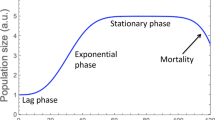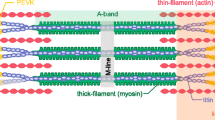Summary
Effects of variation of pH (7.0–7.9) on myocardial concentrations of high energy phosphate, creatine and inorganic phosphate were investigated in isolated guina pig hearts over a period of 2 h. Remarkable changes were observed in the myocardial concentration of inorganic phosphate and in the mass action ratio of the creatine kinase. The myocardial concentration of inorganic phosphate is generally elevated up to 140% at higher, and reduced at lower pH-values. The mass action ratio of the creatine kinase increases up to 200% at pH 7.9 with a time lag of 1 h and decreases at pH 7.0. The changes in the mass action ratio are much smaller than those, which can be calculated from the creatine kinase equilibrium, especially with respect to participation of H+-ions. Intracellular compartmentalisation of metabolites and flow equilibrium involving two isoenzymes of creatine kinase at different cellular sites are discussed as possible explanations of the discrepancies between the observed and calculated mass action ratio.
Similar content being viewed by others
Literatur
Baskin, R. J., Deamer, D. W.: A membrane-bound creatine phosphokinase in fragmented sarkoplasmic reticulum. J. biol. Chem.245, 1345–1347 (1970).
Benson, E. S., Freier, E. F., Vijums, R.: Carbon dioxide dissociation curve and buffer capacity of dog heart muscle. Amer. J. Physiol.209, 941–944 (1965).
Bernt, E., Bergmeyer, H. U., Möllering, H.: Kreatin. S. 407–410. In: Methoden der enzymatischen Analyse. Hrsg: H. U. Bergmeyer. Weinheim: Verlag Chemie 1962.
Brown, E. B., Goot, B.: Intracellular hydrogen ion changes and potassium movement. Amer. J. Physiol.204, 765–770 (1963).
Carter, N. W., Rector, R. C., Campion, D. S., Seldin, D. W.: Measurement of intracellular pH of skeletal muscle with pH-sensitive glass microelectrodes. J. clin. Invest.46, 920–933 (1967).
Clancy, R. L., Brown, E. B.: In vivo CO2 buffer curves of skeletal and cardiac muscle. Amer. J. Physiol.211, 1309–1612 (1966).
Fleckenstein, A., Janke, J., Gerlach, E.: Konzentration und Turnover der energiereichen Phosphate des Herzens nach Studien mit Papierchromatographie und Radiophosphor. Klin. Wschr.37, 451–459 (1959).
Gercken, G.: Die quantitative enzymatische Dehydrierung von L(+)-Lactat für die Mikroanalyse. Hoppe-Seylers Z. physiol. Chem.320, 180 (1960).
Gerlach, E., Bader, W., Schwörer, W.: Über den Stoffwechsel säurelöslicher Phosphor-Verbindungen in der Rattenniere. Pflügers Arch. ges. Physiol.272, 407–433 (1961).
—, Deuticke, B.: Einfache Methode zur Mikrobestimmung von Phsophat in der Papierchromatographie. Biochem. Z.357, 477–479 (1963).
—, Janke, J.: Papierchromatographische Bestimmung von Kreatinphosphat und Orthophosphat in Gewebsextrakten. Biochem. Z.330, 565–575 (1958).
Gray, B. A.: The rate of aproach to equilibrium in the uncatalyzed CO2 hydration reactions: The theoretical effect of buffering capacity. Resp. Physiol.11, 223–234 (1971).
Heldt, H. W., Klingenberg, M.: Differences between the reactivity of endogenous and exogenous adenine nucleotides in mitochondria as studied at low temperature. Europ. J. Biochem.4, 1–8 (1968).
Hill, A. V.: Influence of the external medium on the internal pH of muscle. Proc. roy. Soc. B144, 1–21 (1955).
Hochrein, H., Döring, H. J.: Die energiereichen Phosphate des Myokards bei Variation der Belastungsbedingungen. Pflügers Arch. ges. Physiol.271, 548 bis 563 (1960).
Janke, J.: Die Aufteilung des intrazellulären ADP, ATP und Orthophosphats in der ruhenden und tetanisch gereizten Froschmuskulatur mittels einer fraktionierten Extraktion. Pflügers Arch. ges. Physiol.300, 1–22 (1968).
Jakobs, H., Heldt, H. W., Klingenberg, M.: High activity of creatine-kinase in mitochondria from muscle and brain and evidence for a separate mitochondrial isoenzyme of creatine-kinase. Biochem. biophys. Res. Commun.16, 516–521 (1964).
Kammermeier, H.: Bestimmung von Kreatin in Gewebsextrakten durch Kombination von papierchromatographischen und fluorometrischen Methoden. (Bisher unveröffentlicht.)
Krautzberger, W., Kammermeier, H., Kammermeier, B.: Energiereiche Phosphatverbindungen im Myokard unter dem Einfluß von Adrenalin, Noradrenalin und Isoproterenol. Pflügers Arch.312, 6 (1969).
Kübler, W., Hähn, N., Hellberg, K., Orellano, L. E., Reidemeister, C. J., Spieckermann, P. G.: Beziehungen zwischen aerobem und an aerobem Energieumsatz des Herzens unter verschiedenen funktionellen Bedingungen. Verh. dtsch. Ges. Kreisl.-Forsch. 31. Tgg., 86–92 (1965).
Nägle, S., Hockerts, Th., Bögelmann, G.: Die Beeinflussung des Kreatinphosphokinase-Gleichgewichts durch pH-Abfall im Herzmuskel unter ischämischen Bedingungen. Klin. Wschr.42, 780–784 (1964).
Nihei, T., Noda, L., Morales, M. F.: Kinetic properties and equilibrium constant of the adenosine triphosphate-creatine transphosphorylase-catalyzed reaction. J. biol. Chem.236, 3203–3209 (1961).
Opie, L.: Effect of extracellular pH on function and metabolism of isolated perfused rat heart. Amer. J. Physiol.209, 1075–1080 (1965).
Ottaway, I. H.: Evidence for binding of cytoplasmatic creatine-kinase to structural elements in heart muscle. Nature (Lond.)215, 521–522 (1967).
Perry, S. V.: The bound nucleotide of the isolated myofibril. Biochem. J.51, 495–499 (1952).
Roos, A.: Intracellular pH and buffering powers of rat muscle. Amer. J. Physiol.221, 182–188 (1971).
Sacks, J., Duckett, W. D., Morgan, S., Schaefer, M.: Free and bound nucleotides in frog and mammalian muscle. Arch. Biochem.122, 591–593 (1967).
Serayderian, K., Mommaerts, W. F. H. M., Wallner, A.: The amount and compartmentalisation of adenosine diphosphate in muscle. Biochim. biophys. Acta (Amst.)65, 443–460 (1962).
Wadell, W. J., Bates, R. A.: Intracellular pH. Physiol. Rev.49, 285–329 (1969).
Yagi, K., Mase, R.: Possible compartimentation of adenine nucleotides in a coupled reaction system composed of F-actomysin-adensione-triphosphatase and creatinkinase, pp. 109–122. In: Molecular biology of muscular contraction. Ebashi, Oosawa, Sekine, and Tonomura, eds. Amsterdam-London-New York: Elsevier 1965.
Author information
Authors and Affiliations
Additional information
Eine vorläufige Mitteilung über Teile der Befunde erfolgte auf der 36. Tagung der Deutschen Physiologischen Gesellschaft, Mainz, Sept. 1969. Pflügers Arch.312, 10 (1969).
Rights and permissions
About this article
Cite this article
Kammermeier, H., Rudroff, W. Funktion und Energiestoffwechsel des isolierten Herzens bei Variation von pH,\(P_{{\text{CO}}_{\text{2}} } \) und HCO −3 . Pflugers Arch. 334, 50–61 (1972). https://doi.org/10.1007/BF00586000
Received:
Issue Date:
DOI: https://doi.org/10.1007/BF00586000




